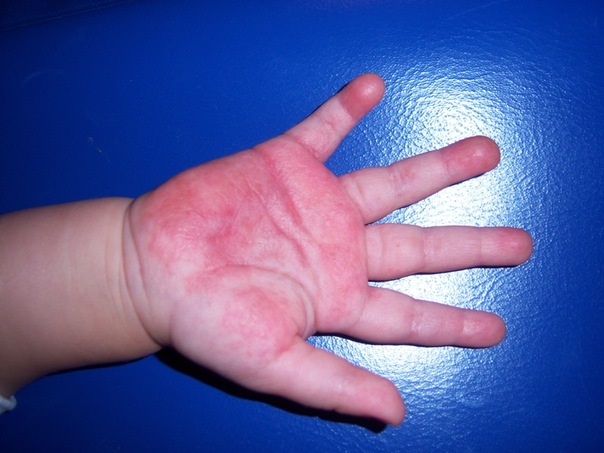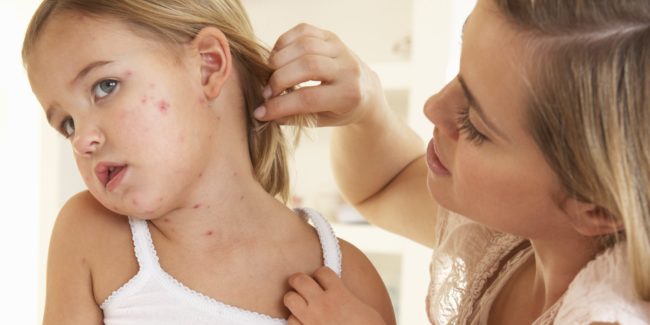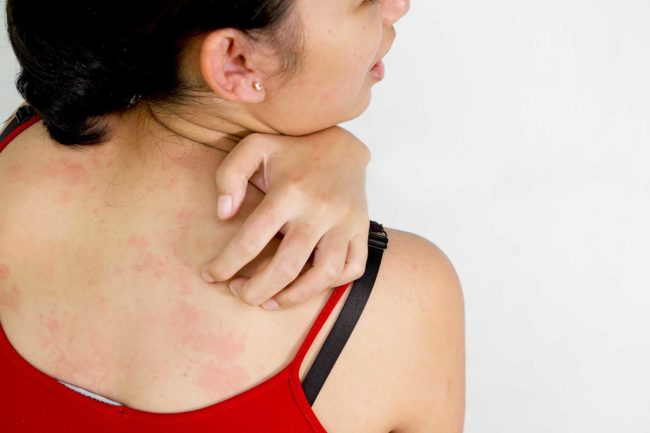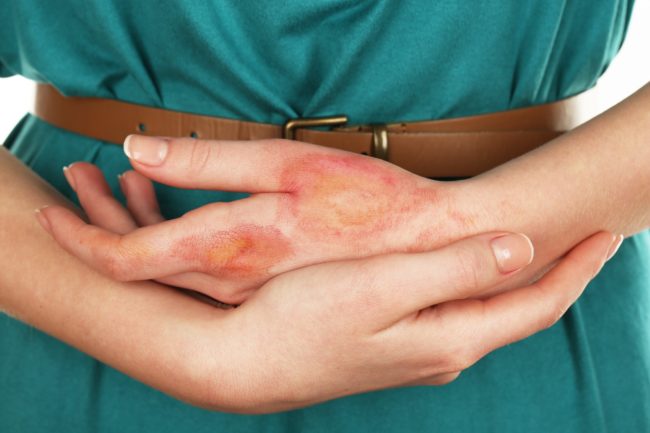Skin diseases cause a lot of inconvenience to a sick person. They are poorly treated, often proceed in chronic form and, in any right case, recur. About 40% of all skin pathologies falls on neurodermatitis. This disease has no age restrictions, and occurs in babies and adults with a genetic predisposition. The trigger mechanism of the disease is poorly understood, but numerous studies show that neurodermatitis provoke factors of allergic and neurological nature. In other words, this skin disease develops as a result of a malfunction of the immune system, on the one hand, and neurological problems on the other. What is the peculiarity of this disease, why it is so often sick and how to treat neurodermatitis is the theme of this article.
Content
What is neurodermatitis?
Neurodermatitis is a chronic disease of the skin, which can be localized throughout the body or on its individual parts, for example, on the hands, head, feet. It manifests itself in the form of papular and itching formations on the skin, with their further merging into the foci of infiltration. Neurodermatitis is characterized by a regular alternation of exacerbations and remissions. In the international list of diseases, it is called atypical dermatitis.
Since neurodermatitis is a disease with the neuro-allergic sources, its first manifestations are noted at an early age, when immunity with the nervous system is still immature. Basically, neurodermatitis in children develops before puberty. And in other cases, neurodermatitis goes into a chronic state.
Neurodermatitis debuts can also be observed at a more mature age under the influence of chronic stress, endocrine deviations and the negative effects of the environment. The “adult” form of neurodermatitis is difficult to treat, and mainly the treatment is aimed at eliminating the symptoms of the disease during the exacerbation period (autumn/winter).
Atipic dermatitis is a neurodermatitis - a modern disease that has shown a strong tendency to growth in recent years. Since the disease has the ability to progress, adults have partial or complete disability, often with subsequent disability. Therefore, the disease requires timely and prolonged treatment.

Neurodermatitis in adults and children - forms of disease
Symptoms and severity of neurodermatitis mainly depends on the form of the disease.
- Limited neurodermatitis. It is more often diagnosed in adults and is manifested by one or more foci (no more than 2-3 affected areas), which are localized on the neck, elbows, in the groin or knees. Also, rashes can appear on the hips, in the anorectal zone, in the back of the head.
- Diffuse neurodermatitis. This form is found both among adults and among children, especially in infants. Skin lesion is more often very extensive and captures the face, neck, stomach, knees, elbows, buttocks. In heavy forms, a complete defeat of the skin from the head for the feet can be observed.
- Linear neurodermatitis. The rashes in appearance resemble horizontal lines and appear on the lower and upper extremities, in the bend of the joints.
- Follicular neurodermatitis. It develops in areas of the skin with many follicles (hair follicles). In adults, the hair of the arms, legs and chest can be affected, and in children the hair area is mainly affected.
- Hypertrophic neurodermatitis. The foci are localized in the inguinal region. In this case, the rash is accompanied by swelling and soreness.
- Psoriasimorphic neurodermatitis. The lesions spread to the head and neck. The rash appears in the form of bright red spots covered with silver scales. Outwardly, this form of the disease is similar to psoriasis, and therefore bears this name.

Neurodermatitis - causes of the occurrence of the disease
The root cause of the development of neurodermatitis is an individual (genetic) predisposition of the immune system to inadequately respond to an external stimulus. But this is not the only condition for the development of the disease. The disease begins to manifest itself and progress in the presence of provoking environmental factors. Among the most common neurodermatitis provocateurs, the following are distinguished:
- The presence of chronic stress, prolonged depression, shocked.
- Physical or psycho -emotional exhaustion.
- Decrease in the performance of the immune system.
- An unbalanced daily routine, for example, insufficient sleep, impaired diet.
- Violation of the work of the nervous center, including all neurological and mental illness.
- Infectious diseases (acute, chronic).
- Disagance violation and the use of a large number of allergenic products.
- Regular administration of drugs.
- Endocrine and cardiovascular changes.
- Intoxication of various etiologies (medication, alcohol, toxic).
Recent studies have shown that people with a congenital concentration of group E immunoglobulins are prone to neurodermatitis, which, with prolonged contact with the allergen, launch the mechanism for the development of atopic dermatitis. Among the most aggressive allergens include:
- Hygienic agents of synthetic origin.
- Polluted air.
- Chlorine water.
- Medicines.
- Nitrates and herbicides.
- Taste additives in products.
- Mixtures for feeding aquarium fish.
- Pollen insects and pets wool.
- Allergic fillers in blankets and pillows (fluff, wool).
The more often a person prone to neurodermatitis on his hands is in contact with these allergens, the higher the risk of the development of the disease.
In babies with a predisposition to this disease, already from the first weeks after birth, such a pathological constitution as a diathesis is diagnosed. Without treatment and appropriate changes in the daily routine and nutrition, it goes into a neurodermatitis with a further increase in symptoms and complications. In this case, with each year, treatment is difficult, and the condition of the child worsens. The transformation of the diathesis into neurodermatitis can occur instantly or delayed for an indefinite period.

Neurodermatitis - symptoms of the disease
The symptomatic picture of neurodermatitis can be expressed in different ways. But absolutely all varieties of the disease are characterized by severe itching, which intensifies closer to the evening and provokes combing the skin to wet wounds.
The first signs of neurodermatitis in children
The main sign of neurodermatitis is an indomitable itch that causes the baby severe discomfort. The child becomes restless, irritable, capriches, refuses feeding and sleeps poorly. Due to constant itching, it begins to comb the skin to the blood, which contributes to the appearance of infection. This is especially dangerous if the child has neurodermatitis on the face, since in this area pathogenic microflora multiplies very quickly.
In an inflamed place, the skin becomes red, dry, inflamed, often peeling. The child has a rash in the form of small bubbles, which can spread to large areas. If the defeat becomes vast, small foci merge, forming large spots. Healthy skin areas are gradually involved, and in the absence of treatment, neurodermatitis acquires a total form of damage.
With neurodermatitis, an increase in the pattern of the skin is noted, it becomes deeper, clear, hyperpigmented.
In children, the disease has its own characteristics, which depend on the age of the baby:
- In newborns, rashes with neurodermatitis are on the feet in the knees and on the face. There is also a rash in the projection of the joints on the hands and on the head. As a rule, neurodermatitis at this age safely takes place up to 3-5 years even without intensive treatment.
- The first appearance of neurodermatitis after a two -year age is accompanied by rashes on the ankle, neck, in popliteal dimples, on the wrists. Sometimes it is difficult to immediately establish a diagnosis, so the kids analyze venous blood and, if necessary, are carried out allergy tests. Therefore, it is impossible to determine the neurodermatitis by the photo or general descriptions of the symptomatic picture. And with the first suspicions of neurodermatitis, you need to contact the pediatrician. Only then can atypic dermatitis be differentiated from the usual manifestation of allergies.
- In adolescence, skin inflammation spreads to the area around the eyes and lips, hands, limbs.

Symptoms of neurodermatitis in adults
In adulthood, neurodermatitis proceeds heavier, and gives a person not only physical, but also psychological discomfort. Therefore, treatment is carried out for more and combined using sedatives.
At the first stage, the condition of the skin remains unused. Only peeling or dryness, which is accompanied by itching, is noted. Then a characteristic rash appears - small pimples that form foci of inflammation. In the process of combing, weeping wounds form. Soon they dry out, and a solid crust is formed.
The affected area has its own distinctive features: in the center, the skin is dense, keratinized, often with cracks; The middle part is densely covered with papules; On the periphery of the hearth, the skin is very pigmented and dry. Along the entire perimeter of inflammation, the skin is covered with scales, it can have deep folds, cracks.
The symptoms of neurodermatitis on the hands, in particular, on the palms, include deep weeping wounds, sometimes with suppuration as a result of infection. Such a picture of the disease reduces working capacity, and limits self -service in everyday life.
Since neurodermatitis is damaged not only immunity, but also a cardiovascular, nervous system. In addition to skin manifestations, such symptoms are noted:
- Emotional lability. This is an accelerated course of reactions of the nervous system in the form of aggression, temper, irritability, unstable mood. The reason for this is the defeat of the parasympathetic nervous system, as well as skin itching and cosmetic skin defect. The symptoms are aggravated by a long -term intake of corticosteroids.
- Sleep rhythm - a condition associated with itching at night. This leads to a breakdown of strength, a decline in disability, asthenia.
- Reducing immunity. The deficiency of group A immunoglobulin in oppresses the barrier function of the skin, which causes purulent damage to sore zones. Herpes, contagious mollusk, warts can also develop. As a result of violation of the adrenal glands, a general deterioration in the immune system is observed, which provokes frequent acute respiratory viral infections, colds, and autoimmune diseases.
- Adrenal dysfunction. Violation on this side provokes the pigmentation of the skin, a drop in the concentration of glucose in the blood, a decrease in daily diuresis, a deficiency of gastric juice, and poor health. Over time, apathy, vulnerability, and oppressed state join these symptoms. Sudden pressure surges appear, the lymph nodes are often inflamed, weight falls, the work of other organs is disturbed.

Neurodermatitis - treatment in adults and children
To prescribe competent treatment, the doctor must correctly make a diagnosis and determine the root cause of the appearance of the neurodermatitis. For this, a full -time examination of the patient is carried out and a list of necessary laboratory tests is assigned.
The tactics of conducting the disease in adults and children are characterized by the duration of treatment and the list of permissible medications. But in general, the treatment consists in taking sedative and anti -inflammatory drugs, the external use of ointments, the passage of physiotherapy and holding a hypoallergenic diet.
Depending on the type of neurodermatitis, the following treatment can be spelled out:
- Antihistamines. They suppress the production of histamine - a substance that provokes an allergic response of the immune system. For adults and children, the intake of suprastin, luratidine, cetirizine is shown.
- Glucocorticosteroids. It can be a gel or ointment from neurodermatitis, such as Sinaflan, Lorinden, Dirgent. The drugs are designed to improve the condition of the skin, relieve itching and reduce the focus of inflammation. In childhood, they are used under the strict control of a dermatologist.
- Vitamin therapy. Neurodermatitis appears due to reduced immunity, so taking B vitamins and ascorbic acid helps restore immunity resistance to skin diseases, and taking tocopherol and retinol provides accelerated skin regeneration.
- Sedatives. Reception of sedatives helps adults get rid of irritability, anxiety and psychological discomfort, and children - to resume sleep and eliminate the tearfulness.
- Skin care. Dry damaged skin requires careful care. Hypoallergenic and antibacterial agents are suitable for these purposes. This allows us to prevent deep weeping cracks and infection.
- Lners and medical bathtubs. To relieve symptoms, various lotions, applications and local baths are used, especially in the treatment of neurodermatitis on the arms and legs. As drugs, resorcin, ichthyol, zinc ointment, pharmacy tar are used. With extensive skin lesions, it is advisable to take baths based on a decoction of chamomile, horsetail, and donnik, coniferous-salt baths are also effective.
- Diet. With neurodermatitis, a lactative-growing diet without preservatives, flavorings and other additives is recommended. Allergens are completely excluded-chocolate, fish, citrus fruits, spices, eggs, legumes.
- Physoalization. During the period of remission, luminaries using UV rays are successfully used. 1-3 courses of 15 sessions are held. Ozokeritopia, electrophoresis, wrap mud is also used. And sanatorium treatment at sea helps to extend the period of remission.
In addition to the main treatment, folk recipes can be used:
- A decoction of oats. A glass of unpeeled oats is poured with 3 cups of boiling water and cooked over low heat 2.5 hours. Then the decoction is filtered and poured into a bath with warm water. The duration of the procedure is 20-25 minutes. This helps to tame itching and reduce peeling.
- Ointment from propolis. You can reduce the foci of rashes using a home -made ointment. To do this, you need to soften the petroleum jelly (100 g) in a water bath and gradually add propolis powder to it (45 g). The cooling field can be applied to the affected areas.
- A calming infusion. To normalize the nervous system, a collection of herbs is prepared. Take part of the root of Valerian, part of the lemon balm, part of the violet, part of the Diaghil and mix. Then 4 tbsp. l. Pour raw materials into a thermos and pour 1 liter of boiling water. After 10-12 hours, you need to take a decoction throughout the day in small portions.

Neurodermatitis is an insidious and difficult to heal disease. Therefore, the success of treatment largely depends on the literacy of a specialist and the patient’s readiness to fulfill all the prescriptions. Listen to the opinion of your doctor and do not self -medicate.









Comments
a couple of years ago, there was no side of metrogils from the same problem, there were no side effects ...
I’m not a fan of peeling at all, it saves from acne of metrogil, it also smoothes it ...
Great article! ...
I take the second course of the Capsules Climafite 911. The tides went very quickly. It became calmer, irritability went away and I sleep well ...
i also noticed - it is worth nervous, everything immediately affects the face. Therefore, I try to avoid conflicts and unpleasant people. Of the creams, I like Miaflow from wrinkles - smoothes not only small wrinkles ...